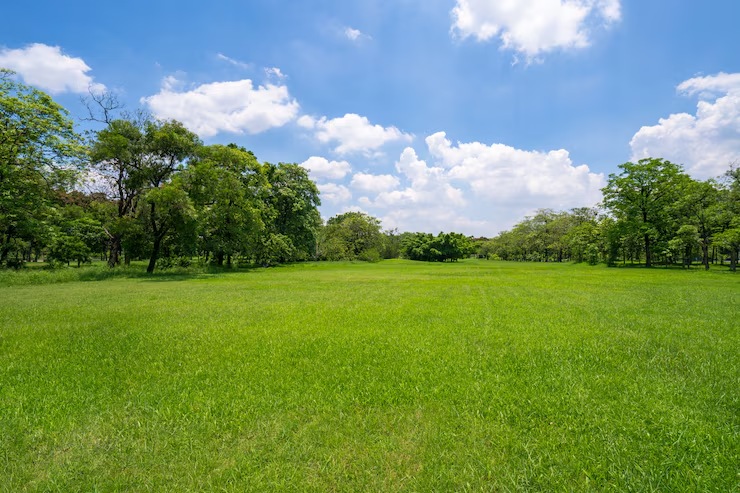Summer’s heat can leave your lawn looking parched and tired. But fear not, fall is nature’s reset button for your green space! With the right care during this season, you can ensure a vibrant, healthy lawn come spring. Here’s a comprehensive guide to transform your fall lawn care routine into a strategy for a flourishing spring spectacle.
Understanding Fall’s Role in Lawn Health
Fall offers the perfect conditions for cool-season grasses, the dominant type in most temperate climates. Cooler temperatures and increased moisture create an ideal environment for root growth and nutrient uptake. By taking advantage of these factors, you can strengthen your lawn’s foundation for a strong comeback in spring.
Fall Lawn Care Essentials
While fall might seem like a time to relax after summer’s maintenance demands, it’s actually a crucial period for proactive lawn care. Here are some key practices to incorporate:
- Mowing: Contrary to popular belief, don’t stop mowing in fall. Continue mowing regularly at a slightly higher height (2-2.5 inches) compared to summer. This allows the grass blades to capture more sunlight for photosynthesis, promoting root growth and winter hardiness.
- Dethatching and Aeration: Dethatching removes the layer of dead grass and organic matter that accumulates at the base of the grass blades (thatch). Aeration involves creating small holes in the soil to improve air, water, and nutrient movement to the roots. Both practices, ideally done in early fall, invigorate the lawn and prepare it to absorb fall treatments.
- Seeding and Overseeding: Fall is prime time for establishing new grass or filling in bare patches. Choose a cool-season grass seed mix suitable for your climate. Overseeding existing lawns helps thicken the turf, deter weeds, and improve overall health.
- Topdressing: After seeding or aeration, apply a thin layer of compost or topsoil to provide a nurturing environment for new seed germination and root development.
- Fertilization: Fall fertilization provides a critical boost of nutrients for root growth and winterization. Choose a slow-release fertilizer formulated for cool-season grasses. Apply according to the instructions and avoid over-fertilizing, which can damage your lawn.
- Watering: Continue watering deeply and infrequently, especially during dry spells. Deep watering encourages roots to grow deep into the soil, making the lawn more resilient to winter stress and drought.
Eco-Friendly Fall Lawn Care Practices
While a healthy lawn is desirable, it’s important to be mindful of the environment. Here are some eco-conscious approaches to fall lawn care:
- Leave the Leaves: Resist the urge to rake up all the fallen leaves. Shredded leaves left on the lawn decompose slowly, returning valuable nutrients to the soil and creating a natural winter mulch for your grass. You can mow over them a few times to chop them up further.
- Compost Clippings: Instead of discarding grass clippings, add them to your compost pile. This provides a natural source of organic matter and nutrients for your lawn and garden.
- Mulch Around Trees and Shrubs: Applying a layer of mulch around trees and shrubs in your lawn helps retain moisture, suppress weeds, and regulate soil temperature. Opt for organic mulch materials like wood chips or shredded bark.
- Go Natural for Weed Control: Before reaching for chemical weed killers, consider natural alternatives like corn gluten meal or vinegar. These methods are less harmful to the environment and beneficial insects.
Beyond the Basics: Advanced Fall Lawn Care Tips
For those seeking to take their fall lawn care to the next level, here are some additional tips:
- Soil Testing: A soil test can reveal your soil’s nutrient composition and pH level. This information helps you choose the right fertilizer and make adjustments if your soil is lacking essential elements.
- Grub Control: If you’ve noticed patches of dead or damaged grass, grubs, the larvae of beetles, might be the culprit. Apply a grub control product in late summer or early fall to prevent further damage.
- Addressing Drainage Issues: Poor drainage can lead to waterlogged soil and lawn problems. If you suspect drainage issues, consider creating a drainage ditch or installing a French drain system.
- Fall Lawn Renovation: For severely damaged lawns, fall can be an excellent time for renovation. This may involve more intensive procedures like core aeration, sodding, or reseeding larger areas.
Conclusion: Fall – The Investment for a Vibrant Spring Lawn
By implementing these fall lawn care practices, you’ll be investing in a healthier, more resilient lawn that thrives in spring. Remember, a lush green lawn not only enhances your curb appeal but also provides valuable environmental benefits. It helps filter stormwater runoff, reduce air pollution, and create a habitat for beneficial insects.

